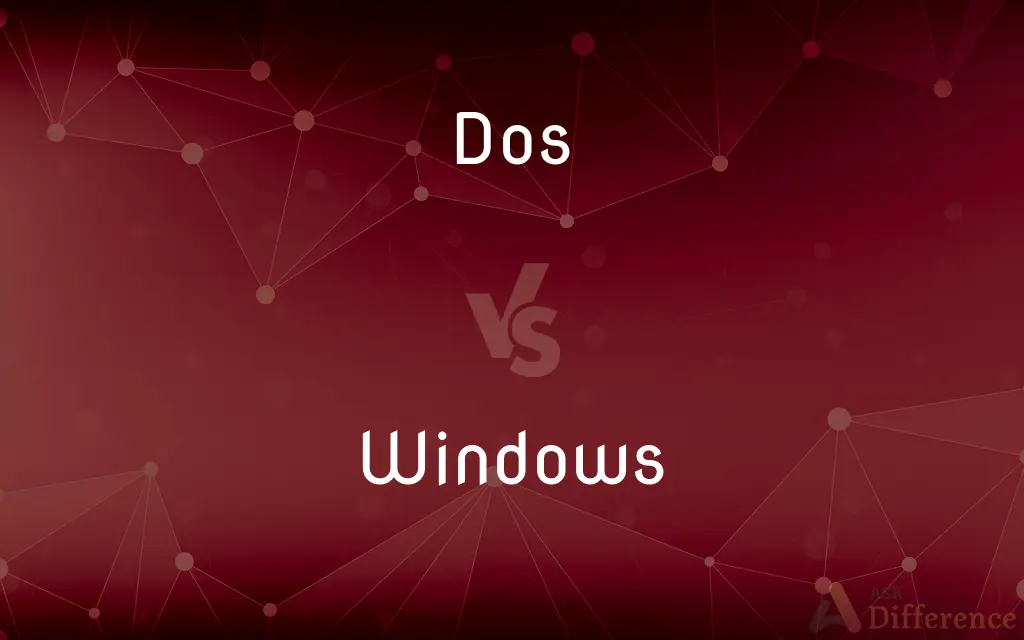DOS vs. Windows — What's the Difference?
By Tayyaba Rehman — Updated on September 21, 2023
DOS is a text-based operating system primarily operated via command lines, while Windows is a graphical user interface (GUI) based OS, allowing more visual and interactive functions.

Difference Between DOS and Windows
Table of Contents
ADVERTISEMENT
Key Differences
DOS, which stands for Disk Operating System, has been a foundational operating system for many early computers. DOS operates predominantly through a command-line interface where users input text commands to perform tasks. Its interaction is essentially keyboard-based, requiring users to type specific commands to initiate actions.
Windows, introduced by Microsoft, revolutionized personal computing by bringing in a graphical user interface (GUI). With Windows, users could now interact with visual elements like icons, windows, and buttons using a mouse. It made computing more intuitive and accessible for many who found the DOS command-line daunting.
While DOS relies heavily on textual commands and manual memorization of those commands, Windows simplifies this with its visual cues, allowing users to click on symbols and drag elements. This shift not only changed user interaction but also altered software development, as programs for Windows were now designed with visuals and user-friendly interfaces in mind.
Another stark difference is multitasking. Windows supports multitasking more efficiently, enabling users to run and switch between multiple applications seamlessly. DOS, being more rudimentary, has limitations in this area, making multitasking more cumbersome.
Over the years, Windows has incorporated and run on top of DOS, especially in its early versions like Windows 95 and 98. However, modern versions of Windows have moved far beyond DOS, establishing themselves as independent operating systems with advanced capabilities and features.
ADVERTISEMENT
Comparison Chart
Interface
Text-based command-line interface
Graphical User Interface (GUI)
Interaction
Keyboard-based commands
Mouse-driven, with icons, buttons, and visual elements
Multitasking
Limited multitasking capabilities
Efficient multitasking across multiple applications
Learning Curve
Steeper, requiring memorization of commands
Intuitive and user-friendly
Evolution
Predates Windows, foundational for early PCs
Developed as an advancement over DOS, offering GUI
Compare with Definitions
Dos
An operating system without a graphical user interface.
Navigating DOS required knowledge of specific textual commands.
Windows
Supports multitasking with visual cues.
On Windows, Sarah could switch between her browser and word processor seamlessly.
Dos
Primarily keyboard-driven interactions.
Without a mouse, DOS users relied on their keyboards for tasks.
Windows
Developed by Microsoft as an evolution over DOS.
Windows 95 was one of the early popular versions of the OS.
Dos
Requires direct textual commands for operations.
To copy a file in DOS, one might use the copy command.
Windows
Allows mouse-driven interactions with on-screen elements.
Double-clicking an icon on Windows would open the associated program.
Dos
A command-line-based Disk Operating System.
John used DOS to run applications on his early computer.
Windows
A graphical user interface-based operating system.
Windows made computer interactions more visual and intuitive.
Dos
A foundational system for early personal computers.
Before the rise of GUIs, DOS dominated the computing world.
Windows
Features windows, buttons, and icons for user interactions.
Customizing the desktop with shortcuts is a feature many Windows users appreciate.
Dos
Any of a family of operating systems that use command lines and were originally developed for personal computers made by IBM.
Windows
A GUI operating system for personal computers.
Dos
Plural of do
Windows
Plural of window
Dos
(music) do
Dos
The federal department in the UnitedStates that sets and maintains foreign policies;
The Department of State was created in 1789
Dos
An operating system that is on a disk
Common Curiosities
Can I run DOS on a modern computer?
Yes, through emulators or specific software, DOS can be run on modern systems.
Did Windows replace DOS?
Windows was developed as a GUI over DOS initially, but modern Windows versions have moved beyond DOS.
Were early versions of Windows based on DOS?
Yes, versions like Windows 95 and 98 ran on top of DOS.
Does Windows support command-line operations?
Yes, Windows has a Command Prompt and PowerShell for command-line tasks.
Is DOS still in use today?
While largely obsolete for mainstream use, DOS is still used in specific niche environments.
Why was Windows developed?
To provide a more user-friendly, graphical interface compared to DOS's command-line.
How did Windows change personal computing?
Windows made computing more accessible and user-friendly with its graphical interface and mouse-driven interactions.
Was DOS only used on personal computers?
Primarily, but variations of DOS were also used on some early workstations and servers.
Why is DOS considered harder to use?
DOS requires memorization of textual commands, whereas Windows is more visual and intuitive.
What was the primary interaction device for DOS?
The keyboard was essential for DOS, with commands being typed in.
Share Your Discovery

Previous Comparison
Skink vs. Lizard
Next Comparison
Leopard vs. LeoponAuthor Spotlight
Written by
Tayyaba RehmanTayyaba Rehman is a distinguished writer, currently serving as a primary contributor to askdifference.com. As a researcher in semantics and etymology, Tayyaba's passion for the complexity of languages and their distinctions has found a perfect home on the platform. Tayyaba delves into the intricacies of language, distinguishing between commonly confused words and phrases, thereby providing clarity for readers worldwide.














































